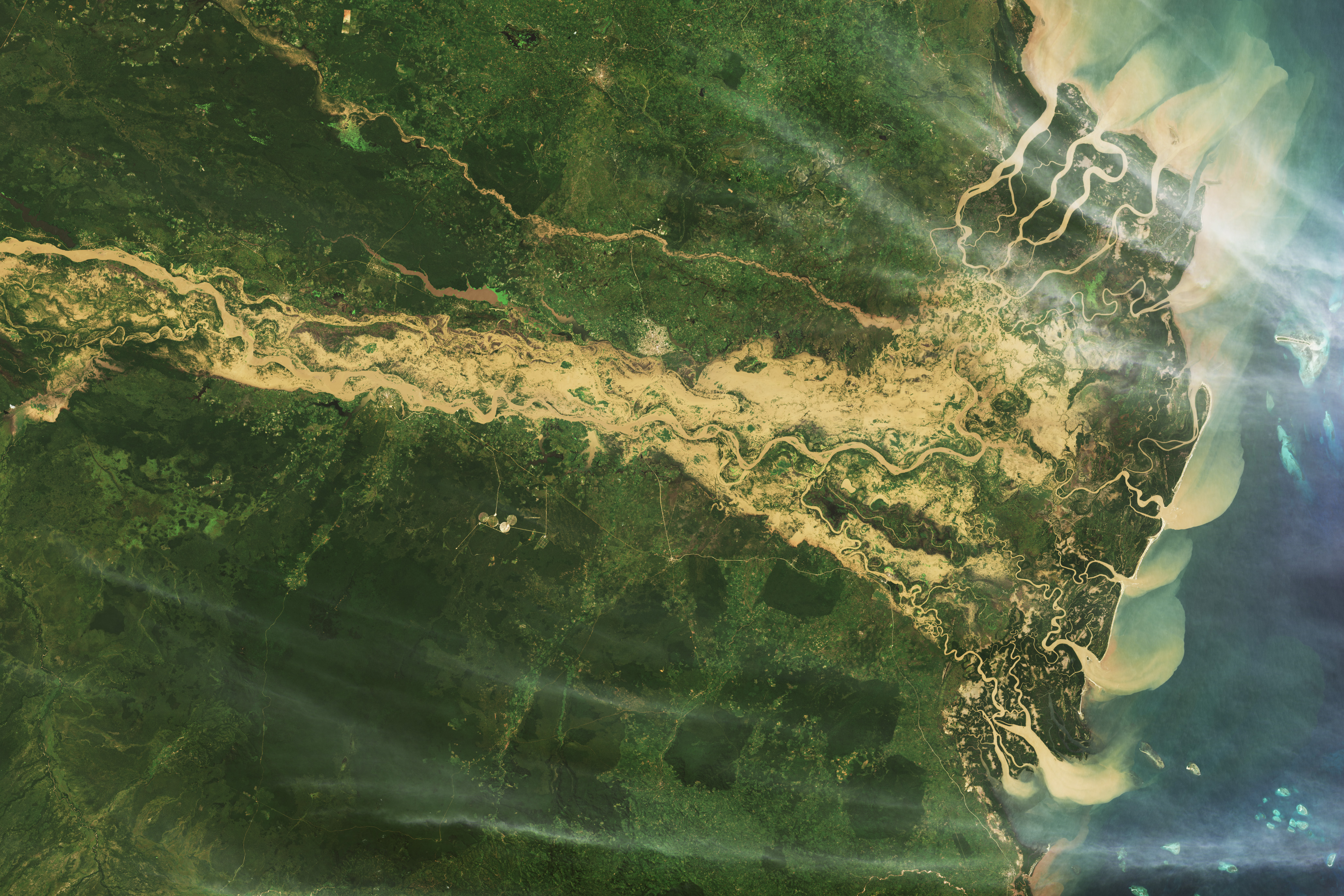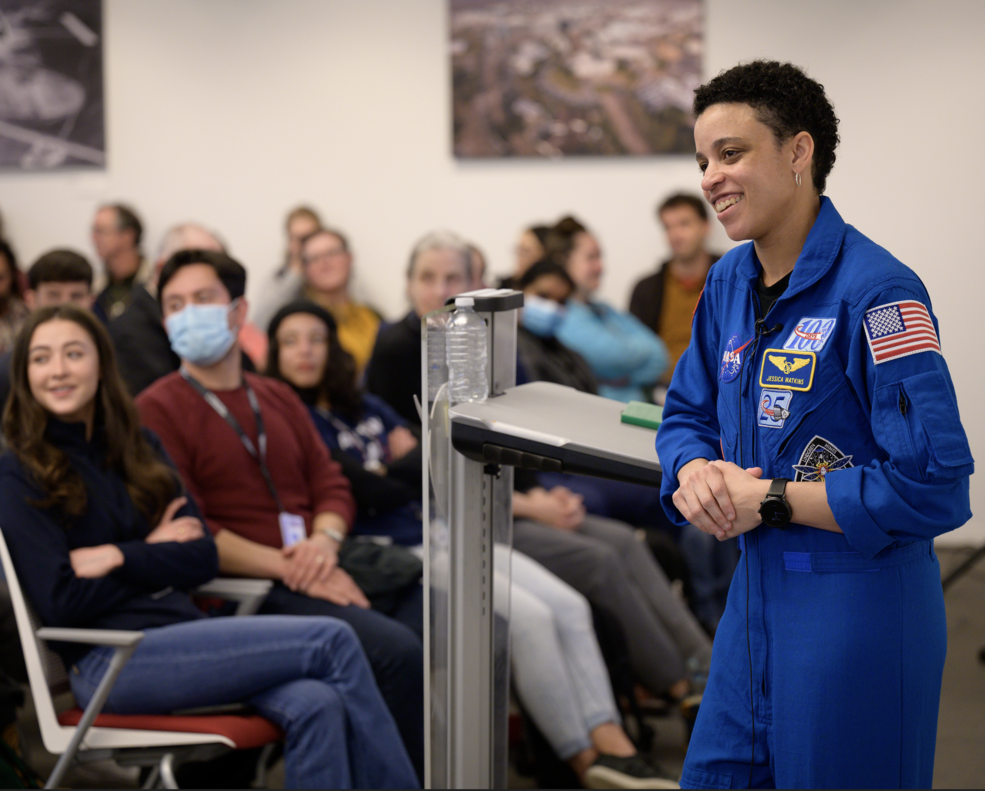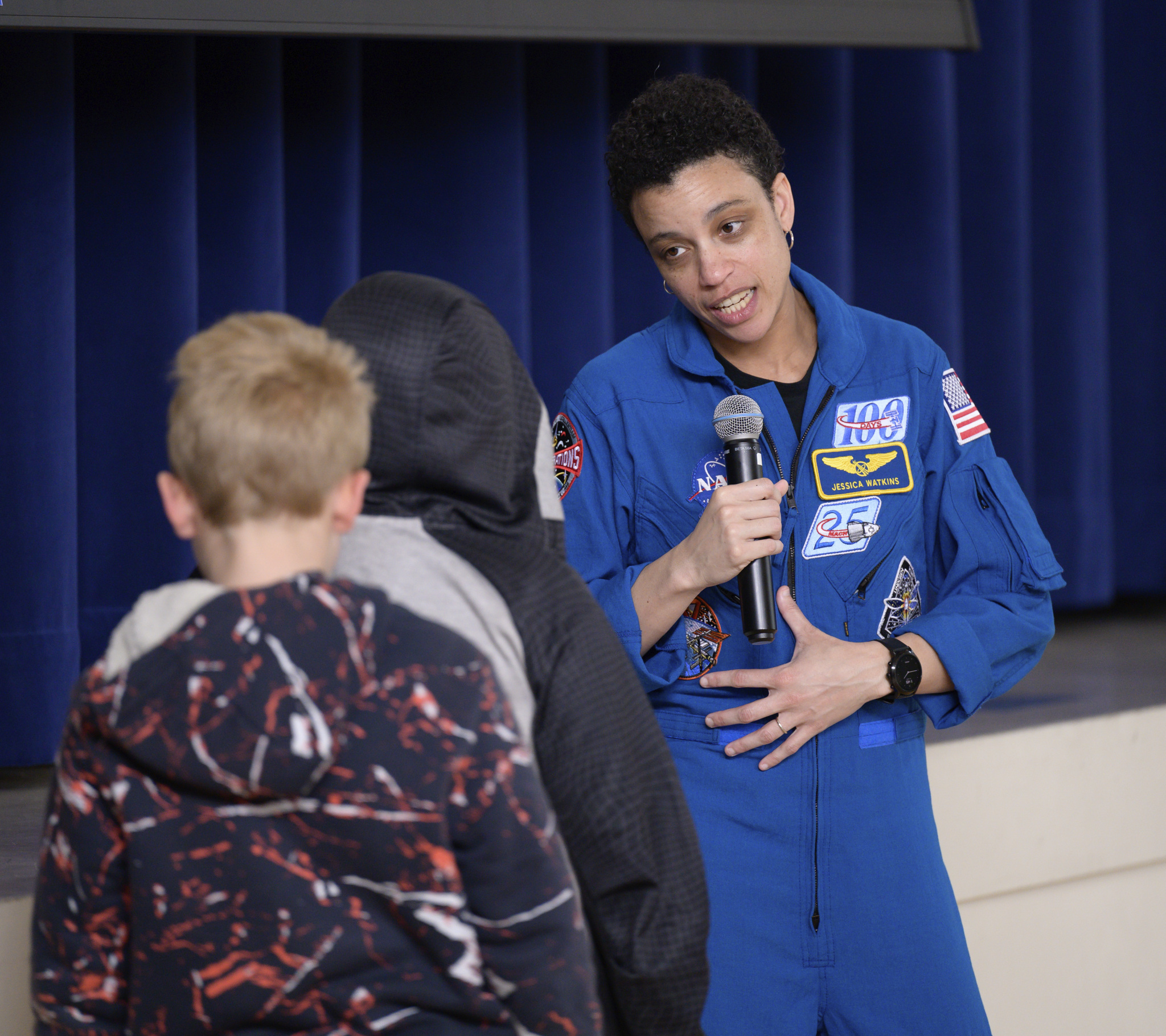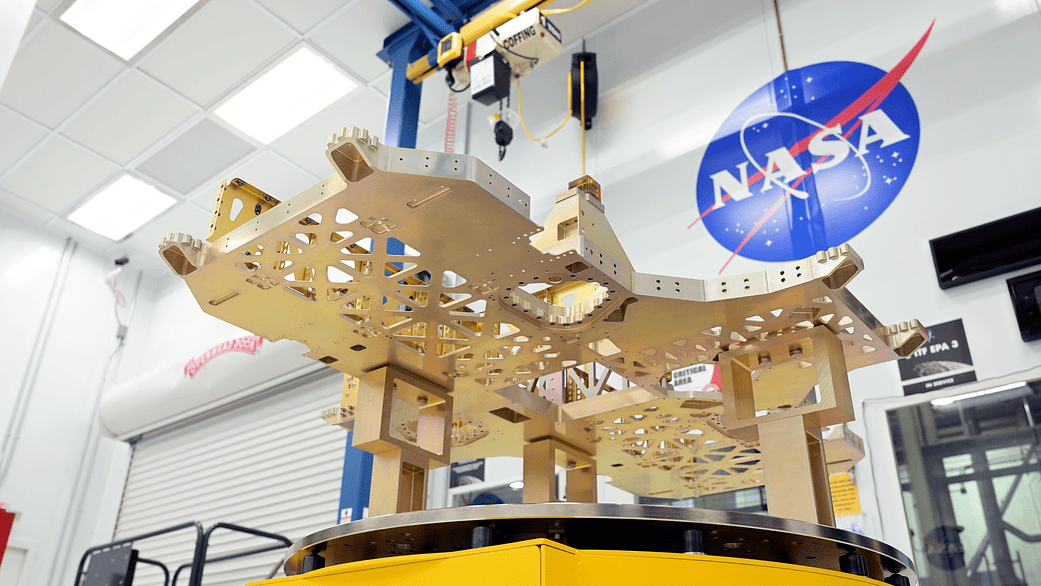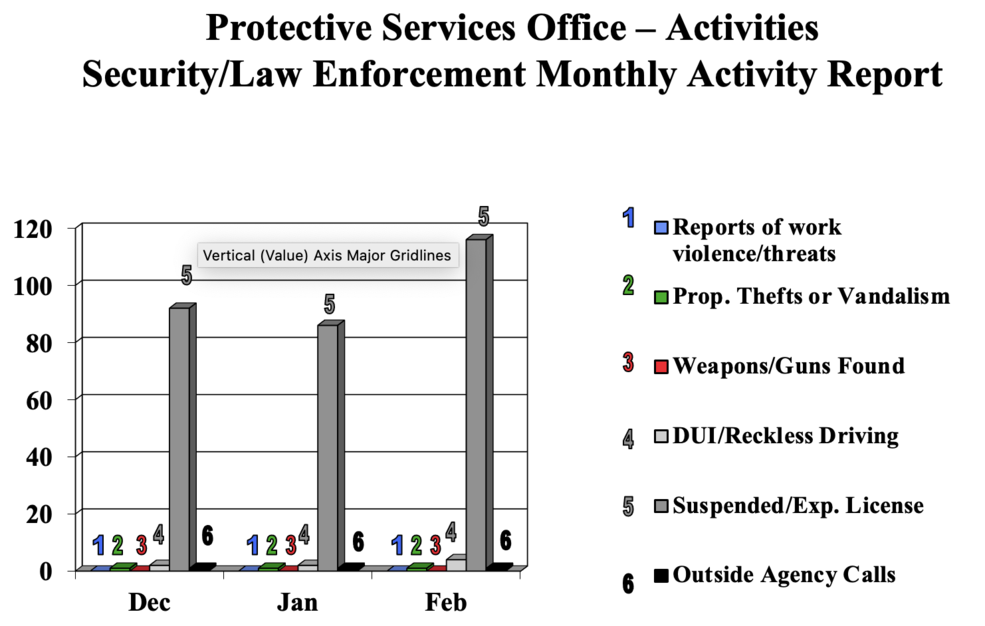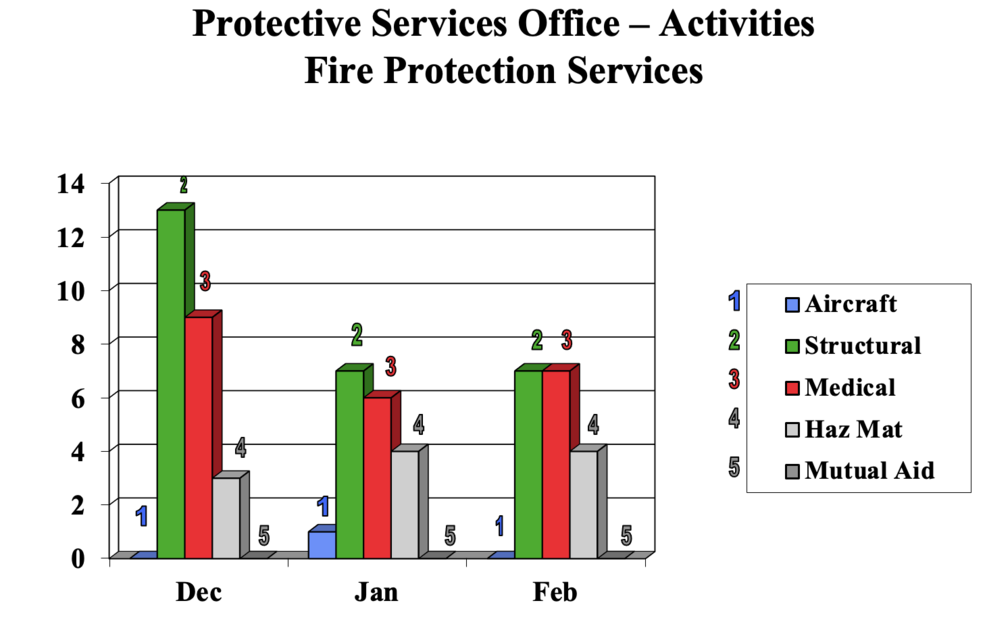NASA Astronaut Jessica Watkins Visits Local School and NASA Ames in Bay Area Homecoming
by Frank Tavares
NASA astronaut Jessica Watkins visited NASA’s Ames Research Center in California’s Silicon Valley on Tuesday, February 28, where she had the opportunity to engage with a local elementary school and speak with Ames employees.
“This really is like coming home for me,” said Watkins while addressing the Ames workforce. “This center has its fingerprints all over my story.”
Watkins is a member of NASA Astronaut Group 22 and the first African American woman to serve to a long-duration mission to the International Space Station. She recently logged a total of 170 days in space over two expeditions as a mission specialist on NASA’s SpaceX Crew-4 mission.
She started her career with NASA at Ames, where she conducted research on Mars soil simulant supporting the Phoenix Mars Lander mission through an undergraduate internship while studying at Stanford University. Her return to the center provided the opportunity to talk to the Ames workforce and share her experiences training as an astronaut candidate and living in space.
In the afternoon, she also visited Mariano Castro Elementary School in Mountain View, California, where she had the opportunity to tour the school, share her experiences, and answer questions from students.
“It was an honor to welcome Jessica back to Ames,” said Center Director Eugene Tu. “The breadth of her experiences and accomplishments is an inspiration to all of us at the center and in the local community.”
Second Gentleman Joins East Bay Kids for NASA Hands-on Artemis Activities
by Rachel Hoover
Nearly 100 East Bay kids and their families got to experience the thrill of “launching a rocket” and “making clouds” at a fun-filled STEM event hosted in honor of Women’s History Month at the East Oakland Youth Development Center in Oakland, California on March 3, 2023.
Second Gentleman Douglas Emhoff along with NASA Ames Research Center Director Dr. Eugene Tu and NASA astronaut Dr. Yvonne Cagle joined kids for the hands-on activities and helped distribute STEM Artemis Learning Lunchboxes aimed to inspire the Artemis generation to learn about NASA’s Artemis Program, which will land the first woman and person of color on the Moon. They were joined by representatives from the National Space Council and other Bay Area STEM organizations.
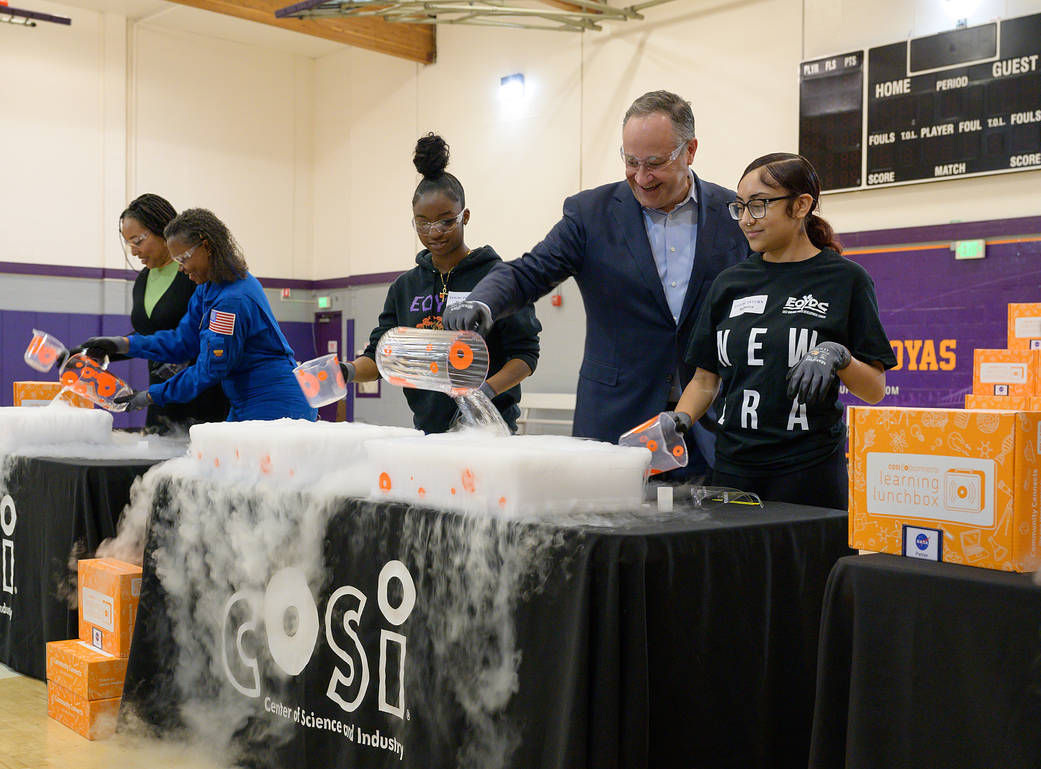
“A key part of our mission is to advance space exploration and to inspire the next generation of explorers in aviation, science, and space,” said Tu when addressing the event attendees. “And that is why we’re here today – we understand that it will take diverse talents and people of all backgrounds for NASA to discover new possibilities and travel farther into space.”
In total, approximately 500 Learning Lunchboxes were handed out to kids at the Manzanita Community School and the East Oakland Youth Development Center in Oakland. The lunchboxes feature five space-focused learning activities that showcase the diversity of STEM at NASA in support of the Administration’s priorities to inspire future scientists, innovators, engineers, mathematicians, and explorers.
The NASA Artemis Learning Lunchbox is made possible through NASA’s Teams Engaging Affiliated Museums and Informal Institutions (TEAM II) program. As part of a larger nationwide STEM initiative with NASA, the Center of Science and Industry (COSI) will distribute 30,000 Artemis Learning Lunchboxes in communities across the country to highlight the importance of STEM.
For more information about NASA’s STEM Engagement, visit: https://www.nasa.gov/stem
NASA Begins Building its First Robotic Moon Rover
by Rachel Hoover
NASA’s first robotic lunar rover is officially coming together and the team building it is over the Moon.
“I’m super excited…it makes me very proud of all the time and effort the team has invested to get this far,” said David Petri, system integration and test lead for the Volatiles Investigating Polar Exploration Rover (VIPER). The team recently began assembling the 1,000-pound rover at NASA’s Johnson Space Center in Houston.
Engineers have affixed the rover’s lower chassis plate and the lower parts of the frame that will support all of VIPER – from the bottom of its wheels to the tip of its headlights. It all now sits atop a set of risers on a specialized lift table in a clean room at Johnson.
“We’ve just completed the first few steps integrating rover components that will one day be on the surface of the Moon,” said Petri. “Hardware is coming in from all over the world, including some manufactured at several NASA centers – it’s really ‘go’ time.”
Over the next few months, engineers and technicians will continue the build-up, adding subsystems such as avionics, power, telecommunications, mechanisms, thermal systems, and navigation systems onto the rover, including the specialized scientific instruments and drill that will perform the primary objectives of the VIPER mission. Once integration is complete, they will put the completed rover through a series of stressful function, performance, and operational tests, followed by vibration, acoustic and thermal-vacuum environmental tests ensuring the rover is mission-ready.
Meanwhile, at NASA’s Ames Research Center in California’s Silicon Valley where the mission is managed, software engineers continue developing and testing the brains of the rover, before it is integrated with the rover hardware. And the VIPER science team continues to simulate the fast-paced science operations in preparation for a target lunar landing date of Nov. 10, 2024. Scientists chose the date to ensure that VIPER, a solar-powered rover, receives the most sunlight possible as it makes frequent stops to study and explore a portion of the large flat-topped Moon mountain Mons Mouton. Using a target landing date, the rover’s science team can continue planning the best path for the rover to take to maximize science results while outrunning cold and dark shadows.
The successful arrival of the first flight science instruments is just the beginning – with more expected to arrive soon, and many other parts staged in preparation for integration – NASA is on track to deliver VIPER in mid-2024 to Astrobotic of Pittsburgh, ahead of a launch in late-2024. Astrobotic is scheduled to deliver VIPER to the Moon’s South Pole aboard its Griffin lander as part of NASA’s Commercial Lunar Payload Services (CLPS) initiative.
Once on the Moon, VIPER will explore and study the environment to better understand the origin and distribution of lunar water and other potential resources. Such findings could be used to help determine where and how the Moon’s resources can be harvested to sustain humans on the Moon for the Artemis program and future human space exploration in deep space.
Study Reveals Map of Moon’s Water Near Its South Pole
by Anashe Bandari, SOFIA Science Center, NASA Ames
A new study using the now-retired Stratospheric Observatory for Infrared Astronomy (SOFIA) has pieced together the first detailed, wide-area map of water distribution on the Moon. SOFIA was a joint project of NASA and the German Space Agency at DLR.
With clear, identifiable lunar features marked out by the water data, the study provides hints about how water may be moving across the Moon’s surface, particularly near its South Pole — an important area for space exploration.
The new map covers about one-quarter of the Earth-facing side of the lunar surface below 60 degrees latitude and extends to the Moon’s South Pole. Given the large region covered, the researchers could easily identify how water relates to surface features on the Moon, staying away from sunlight and favoring cold areas.
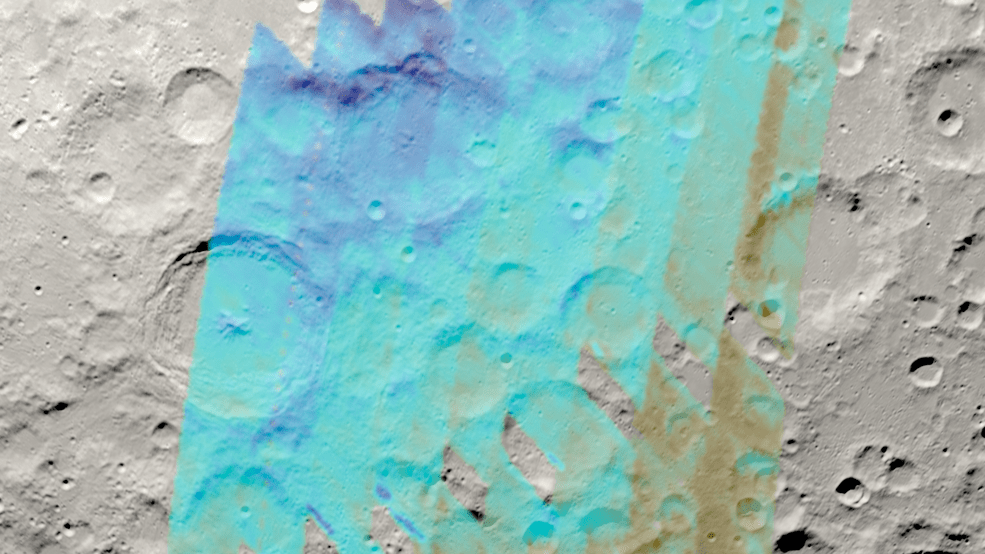
“When looking at the water data, we can actually see crater rims, we see the individual mountains, and we can even see differences between the day and night sides of the mountains, thanks to the higher concentration of water in these places,” said Bill Reach, director of the SOFIA Science Center at NASA’s Ames Research Center in California’s Silicon Valley and lead author on the study, which was presented at the 2023 Lunar and Planetary Science Conference.
In late 2024, NASA’s Volatiles Investigating Polar Exploration Rover (VIPER) will land in the region studied by SOFIA, atop Mons Mouton, to conduct the first resource mapping mission beyond Earth. The flat-topped lunar mountain will be a region of emphasis in the next paper from the team that led the current study of SOFIA data.
This current finding, along with two previous SOFIA results about the amount and distribution of water on the Moon’s sunlit surface, tracks a unique light signature of water. Other missions observing wide areas of the lunar surface have studied different wavelengths of light, which can’t distinguish water from similar molecules, such as hydroxyl. The Moon’s water is present in the soil and might be found as ice crystals, or as water molecules chemically bound to other materials.
Instead of determining the absolute quantity of water in the region, the researchers compared the data obtained around the Moon’s South Pole to a relatively dry reference region near the Moon’s equator to see how its abundance changes. The water was found in greater concentrations on the shadowed sides of craters and mountains, similar to the way skiers on Earth know the slopes receiving less direct sun retain snow longer. This suggests the Moon’s local geography plays an important role in the amount of water present.
As NASA prepares to send astronauts back to the Moon under Artemis, the agency has identified 13 candidate landing regions near the lunar South Pole. Through Artemis, NASA will land the first woman and the first person of color on the Moon, and lunar water could be a critical resource for establishing a long-term human presence.
“With this map of SOFIA data, and others to come, we are looking at how water is concentrated under different lunar environmental conditions,” said Casey Honniball, a visiting assistant research scientist and VIPER science team member at NASA’s Goddard Space Flight Center, in Greenbelt, Maryland, who was involved in the work. “This map will provide valuable information for the Artemis program on potential prospecting areas but also provides regional context for future science missions, like VIPER.”
In addition to the southern region for which the new map results were created, SOFIA observations of sites relevant to other missions are in the archive and now being analyzed. NASA Artemis-related missions will target both polar and non-polar regions, including Lunar Trailblazer, which will orbit the Moon to map its hydroxyl and water.
Where the Moon’s water may be coming from — whether it is ancient and exists inherently in the Moon’s minerals as a result of early volcanic processes on the Moon or is contemporary and delivered by asteroids, comets, or solar wind, and whether it is migrating along the Moon’s surface — is another important question left open by the SOFIA observations. VIPER will aim to better understand this distinction, which is important in determining if the water is widespread and deep within the surface, or only scattered at or near the surface.
It’s clear, however, that even at its lowest limit, the Moon contains much more water than we once believed.
“Our common knowledge from the Apollo era that the Moon is bone dry was wrong,” said Paul Lucey, a professor at the University of Hawaii at Mānoa and co-author on the paper. “We already know it’s wrong, but the question is by how much.”
SOFIA was a joint project of NASA and the German Space Agency at DLR. DLR provided the telescope, scheduled aircraft maintenance, and other support for the mission. NASA’s Ames Research Center in California’s Silicon Valley managed the SOFIA program, science, and mission operations in cooperation with the Universities Space Research Association, headquartered in Columbia, Maryland, and the German SOFIA Institute at the University of Stuttgart. The aircraft was maintained and operated by NASA’s Armstrong Flight Research Center Building 703, in Palmdale, California. SOFIA achieved full operational capability in 2014 and concluded its final science flight on Sept. 29, 2022.
In Memoriam …
Former Ames Scientist and BBC Wales Live Reporter of the Apollo Moon Landings John Orion Thomas Passes
John Orion Thomas, a BBC Wales live reporter of the Apollo Moon Landings, former assistant chief in Space Sciences at Ames, and a Ph.d. in physics, passed on Feb. 19 at the age of 96. John was born in 1926 in Sunny Bank, Grovesend, Wales, to parents Maggie Evans and Thomas Evans Thomas. In order to escape the Welsh mining villages, he obtained a degree at Swansea University at the age of 17. This allowed him to gain a scholarship, and later become president of Swansea University where he studied for his masters in physics. Always fascinated in music, he won the Eisteddfod Gadeiriol Myfyrwyr Cymru in 1945, playing violin, and again in 1953, with his choir’s interpretation of ‘Mawr yw Jehofa’.
During that time, his National Service took him to London, where he assisted in the development of radar for the detection of military planes. He returned to Swansea to complete his Ph.D. in 1953, before moving to the Cavendish Laboratories in Cambridge, where he met his wife of nearly 70 years, Denise. He was made a fellow of Fitzwilliam College in 1959-63, where he tutored in physics and continued his research into radio and remote sensing. Here he learned to fly Tiger Moth planes and received the certificate of proficiency by the Air Training Corps.
In 1963, the couple moved to Stanford University, California, as a visiting lecturer, before joining NASA Ames as assistant to the chief of Space Sciences. It was here that he became fascinated with space science, atmospheric physics, and the structure of the Ionosphere; 80-1000km up, the layer of the earth’s atmosphere which contains a high concentration of ions and electrons – and is able to reflect radio waves. His research in this area aided in the design and operation of radar and telecommunications still in use today.
Returning to the UK, he lectured at Imperial College from 1965 to 1986, and became editor of the Journal of Remote Sensing, chairman, and later president of the Remote Sensing Society. In 1969, due to his Welsh heritage and experience at NASA, he provided live television coverage of the Moon landings to a Welsh speaking audience for BBC Wales.
It was around this time that he set up his own computer software company. Building on his expertise in atmospheric science and remote sensing, among other things, he helped the Ministry of Defense devise techniques to track the movements of submarines from space. This was accomplished by detecting the waves on the surface of the oceans, a technique which has since been adopted to aid conservation by tracking the migrations of various species of Whales around the world.
John died following a short illness in a nursing home in Abingdon, Oxfordshire where he had spent his last three years with his wife Denise. He is preceded in death by his brothers Hugh, Peris, Tyrell and survived by his sister, Margaret Evans, wife Denise Thomas, children Adrian, Martin, Allison, Julian and Julia and their six grandchildren.
Statistical Summary of Activities of the Protective Service Division’s Security/Law Enforcement and Fire Protection Services Units for Period Ending February 2023
















